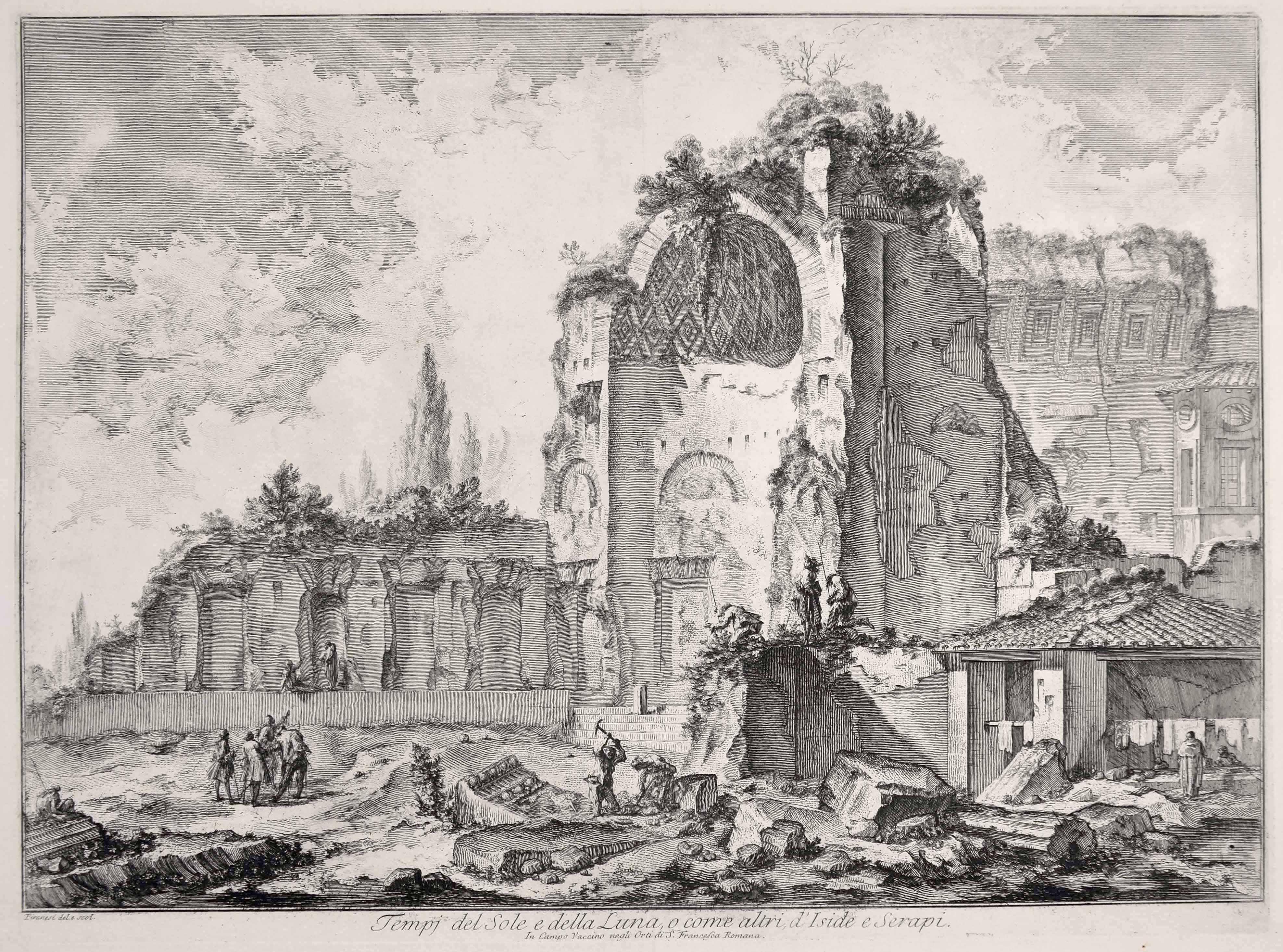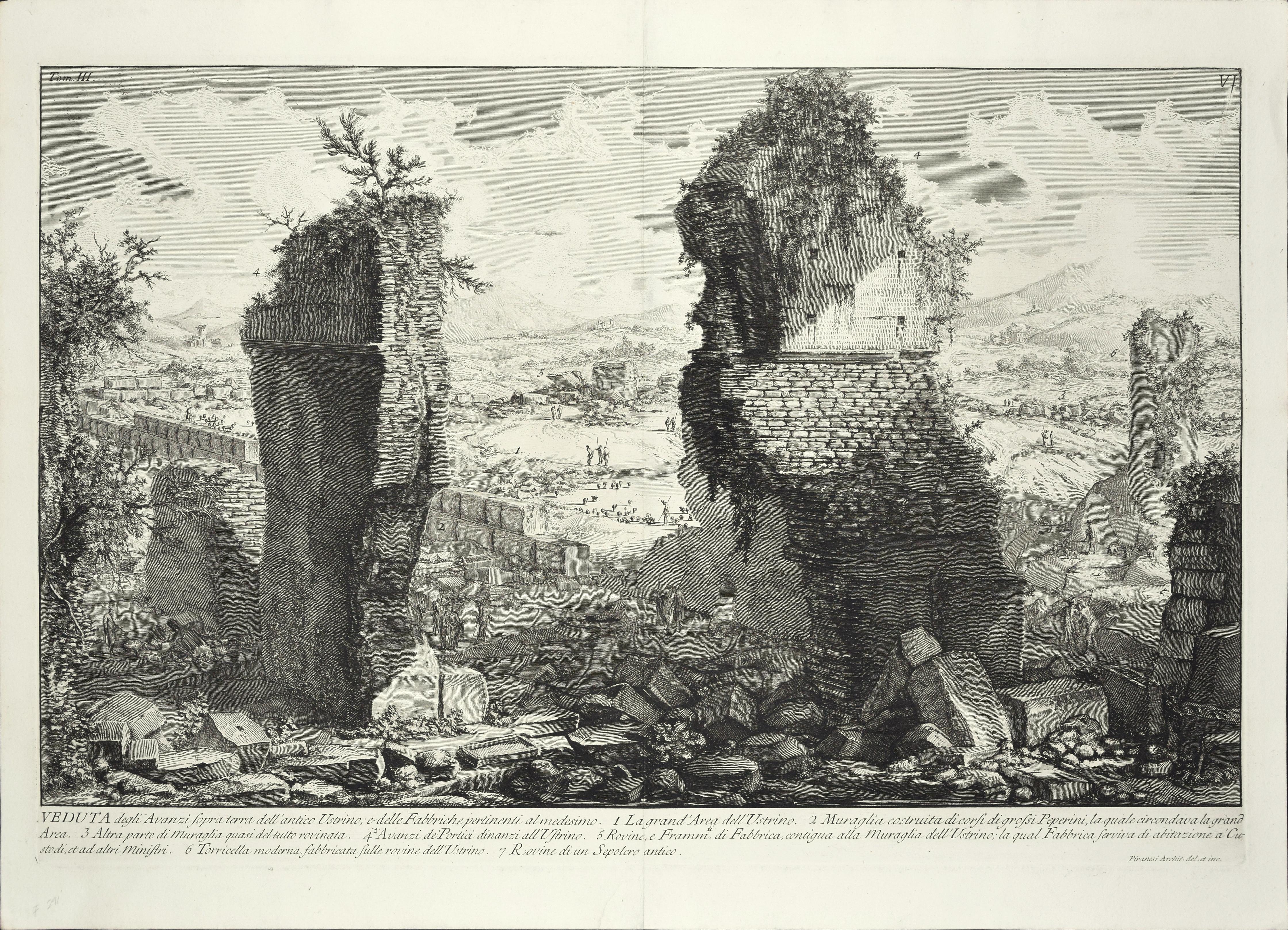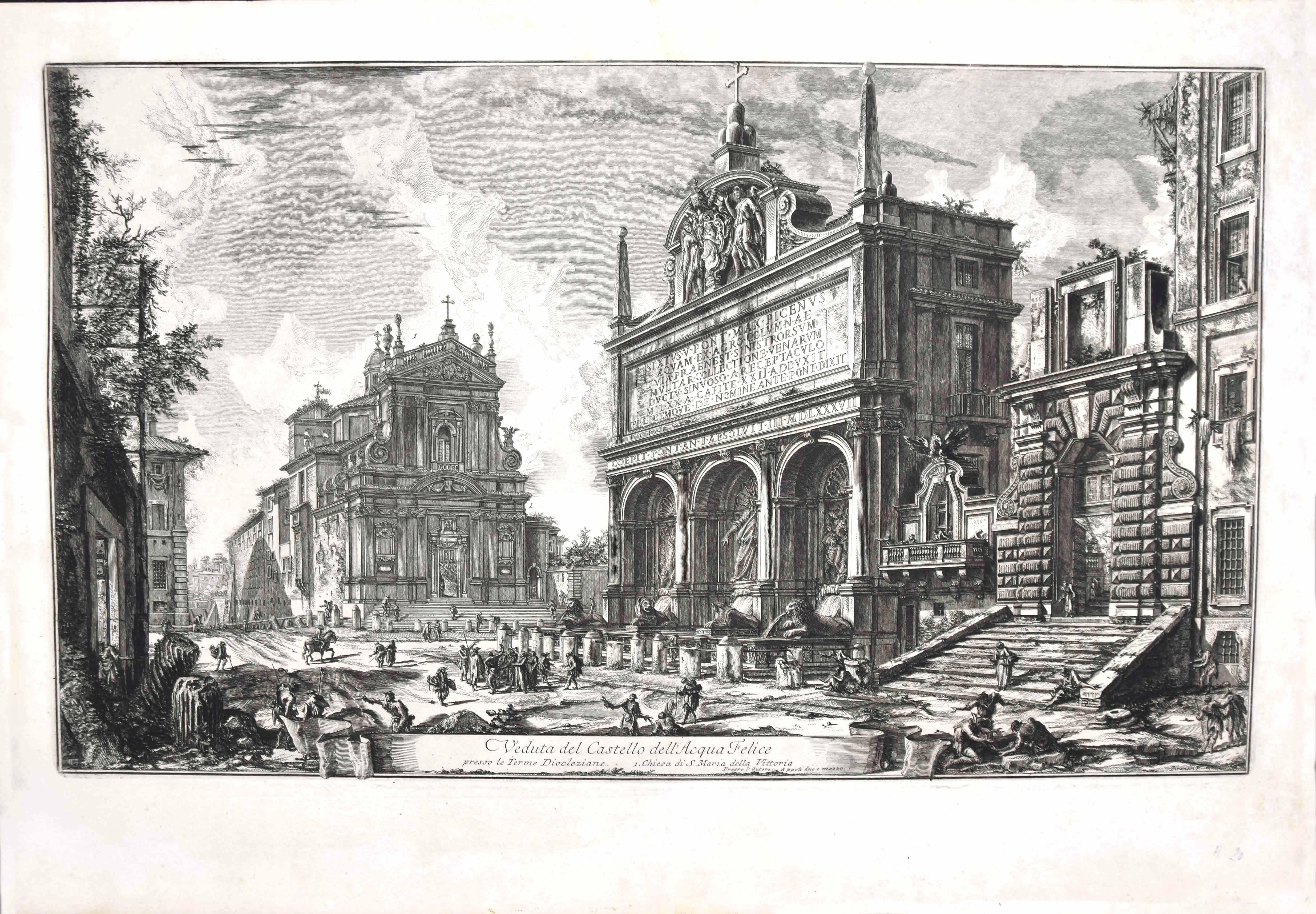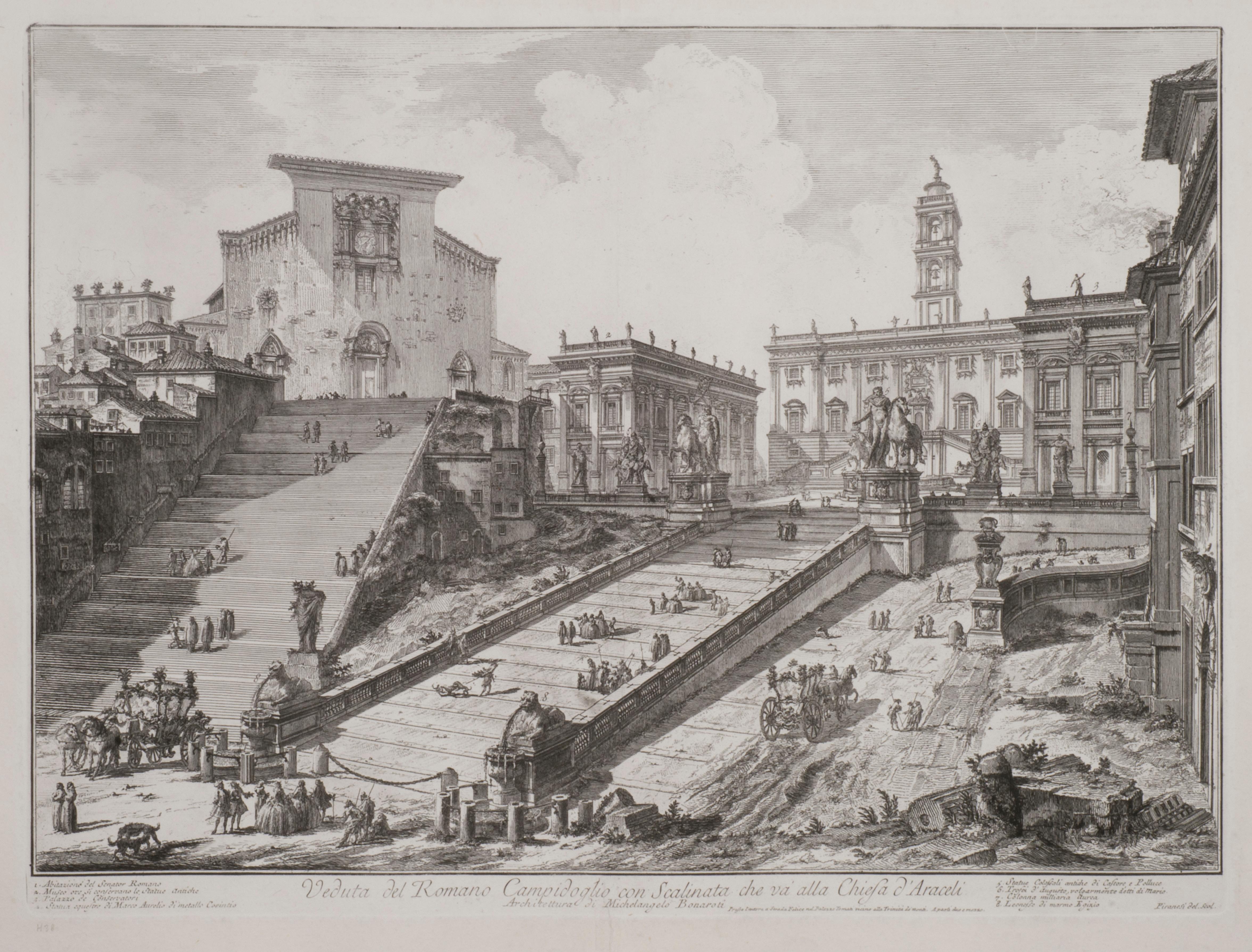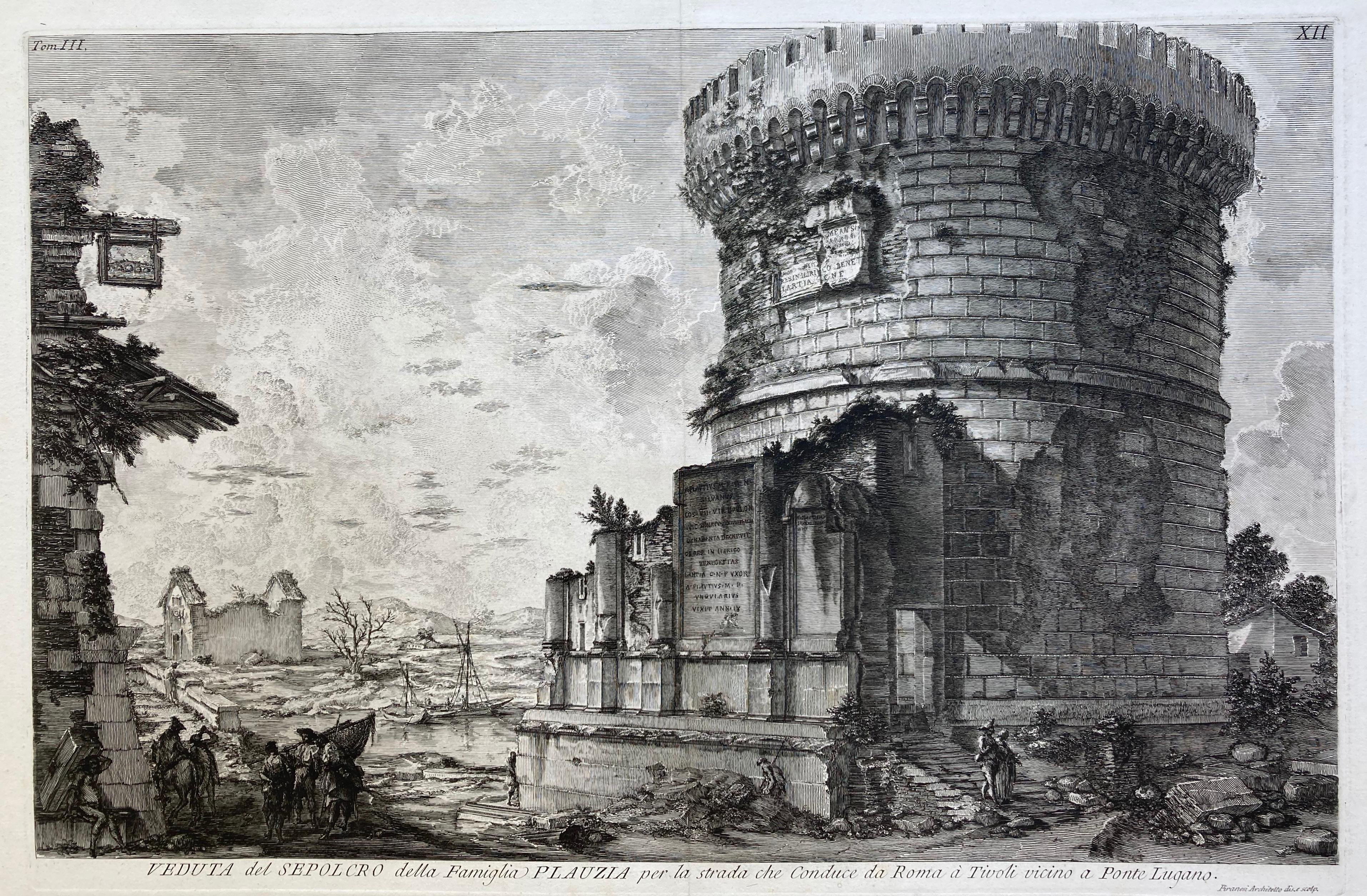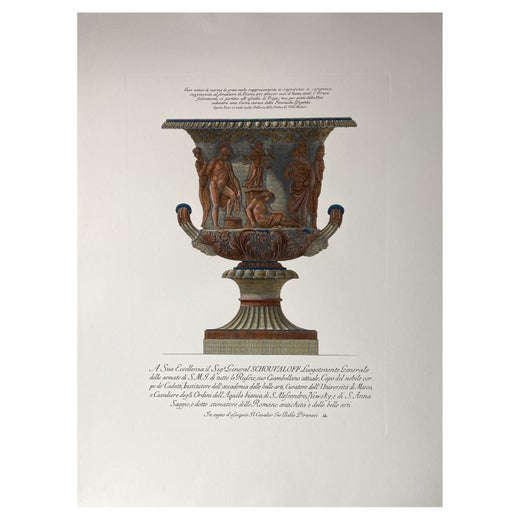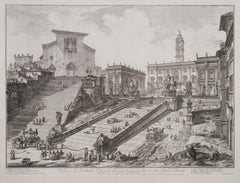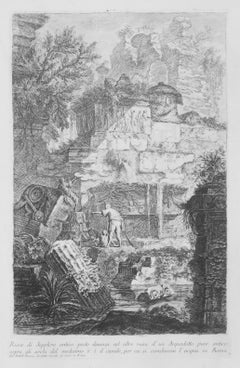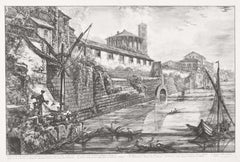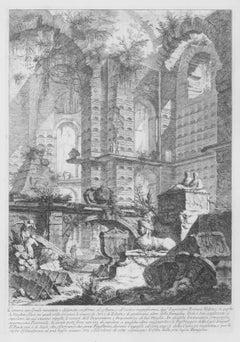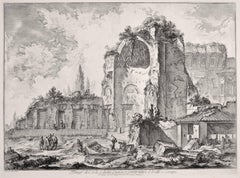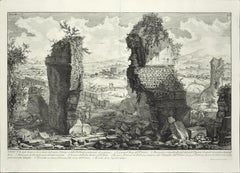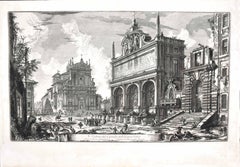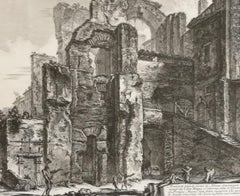Items Similar to XXXIII Fig. I Avanzo del Tempio di Castore e Polluce
Want more images or videos?
Request additional images or videos from the seller
1 of 6
Giovanni Battista PiranesiXXXIII Fig. I Avanzo del Tempio di Castore e Polluce1756
1756
$425
£320.74
€367.19
CA$599.39
A$658.06
CHF 343.31
MX$7,963.40
NOK 4,302.85
SEK 4,054.42
DKK 2,741.01
About the Item
XXXIII Fig. I Avanzo del Tempio di Castore e Polluce .View of the Remains of the Peristyle of the House of Nero,
Etching, 1756
Signed in the plate (see photo)
From: Le Antichità Romane (Roman Antiquity), 1756-1757, Four Volumes
From the first edition, printed in Roma, 1758
Publisher: Angelo Rotili
Watermark: Double Circle Fleur de Lys
Inscription: At upper left: Fig. XXXVI
At bottom center: Veduta dell' Avanzo del Peristilo della Casa Neroniana
At lower right: Piranesi Archit. dis. inc.
Condition: Excellent
Plate/Image size: 5 1/8 x 7 5/8 inches
Sheet size: 8 3/4 x 11 5/8 inches
Reference: Focillon 20.A.213
Wilton_Ely 392.348
Provenance: Dale Zimmerman (1928=2021), noted artist and collector
“Piranesi spent his first few years in Rome measuring and sketching ancient architectural sites. The results of Piranesi’s comprehensive research were presented in the four volumes of the Antichità Romane (1756). This production rapidly earned Piranesi an international reputation, as evidenced by his election to the Honorary Fellowship of the Society of Antiquaries of London a year later. Antichità Romane itself set out to provide a sweeping overview of the archaeological information on Ancient Rome Piranesi gathered over the years. Its purpose was the education of contemporary designers and their patrons. The more than 250 images feature original methods of illustration, combining an impressive amount of data and skilled etchings into a single plate. As depicted in the views of the burial chamber and tomb, Piranesi balances the picturesque appearance of Roman architecture with detailed explanatory text in one plate. Piranesi’s expansive topographical knowledge of Rome allowed him to place the many diverse and isolated ancient remains into the broader context of Rome’s new urban development. 21 The Antichità Romane represented a milestone in the history of classical archaeology, a newly established area of study for historians. Classical archaeology became popular, or valued, after the discovery of Pompeii and Herculaneum, sites that piqued the interest of many intellectuals and aristocrats. Besides representing a massive advance in the how archaeological discoveries were communicated to the broader public, the Antichità Romane focused attention in a visually stunning way to neglected aspects of antiquity, such as the techniques of Roman building science and non-traditional Roman decoration. The Antichità Romane was set apart from the work of Piranesi’s peers due to the greater spectrum of buildings he included in the work and by the way he placed them within landscape settings, often with the addition of figures. The figures within Piranesi’s etchings often hint towards the sublime, an art style defined by the seemingly overwhelming terror of nature looming over mankind. In the early 18th century, nature was determined to be a devastating force that needed to be controlled; control over nature represented the control one had over man. The sublime was introduced as philosophers and intellectuals from France and Britain came to see that the overwhelming powers of nature were, in a way, beautiful, because of the pure terror and emotion it incited in viewers. Piranesi’s miniscule figures and grand, vast structures represent the relationship people of the 18th century believed they had with nature and ancient ruins. The Antichità Romane, and his sublime images of ruins, allowed Piranesi to make a name for himself as an antiquarian.” Courtesy: Wellesley Davis Museum of Art
- Creator:Giovanni Battista Piranesi (1720-1778, Italian)
- Creation Year:1756
- Dimensions:Height: 5.13 in (13.04 cm)Width: 7.63 in (19.39 cm)
- Medium:
- Movement & Style:
- Period:1750-1759
- Condition:
- Gallery Location:Fairlawn, OH
- Reference Number:Seller: FA122701stDibs: LU14015317712
Giovanni Battista Piranesi
Piranesi was born in Venice in 1720 and died in Rome in 1778. He was the son of a stone mason and was trained as an architect. After a slow start he eventually achieved great success as an architect, archaeologist, artist, designer, collector, and antiquities dealer. His mission was to glorify the architecture of ancient Rome through his engravings and etchings. His highly dramatized prints often depict imaginary interiors and frequently include figures in mysterious activities, who are dwarfed by the magnitude of their monumental surroundings. Piranesi's style greatly influenced the neoclassical art movement of the late 18th century. His dramatic scenes inspired generations of set designers, as well as artists, architects and writers. His prints have continued to increase in value to institutions and collectors.
About the Seller
5.0
Recognized Seller
These prestigious sellers are industry leaders and represent the highest echelon for item quality and design.
Platinum Seller
Premium sellers with a 4.7+ rating and 24-hour response times
Established in 1978
1stDibs seller since 2013
814 sales on 1stDibs
Typical response time: <1 hour
Associations
International Fine Print Dealers Association
- ShippingRetrieving quote...Shipping from: Fairlawn, OH
- Return Policy
Authenticity Guarantee
In the unlikely event there’s an issue with an item’s authenticity, contact us within 1 year for a full refund. DetailsMoney-Back Guarantee
If your item is not as described, is damaged in transit, or does not arrive, contact us within 7 days for a full refund. Details24-Hour Cancellation
You have a 24-hour grace period in which to reconsider your purchase, with no questions asked.Vetted Professional Sellers
Our world-class sellers must adhere to strict standards for service and quality, maintaining the integrity of our listings.Price-Match Guarantee
If you find that a seller listed the same item for a lower price elsewhere, we’ll match it.Trusted Global Delivery
Our best-in-class carrier network provides specialized shipping options worldwide, including custom delivery.More From This Seller
View AllVeduta del Romano Camipidpglio con scalinata che va alla chisea d’Araceli (The C
By Giovanni Battista Piranesi
Located in Fairlawn, OH
Veduta del Romano Camipidpglio con scalinata che va alla chisea d’Araceli (The Capitol and the Steps of S. Maria in Aracoeli)
Etching, 1775
Watermark: Double Circle Fleur de Lys
A lifetime impression with the price etching in the plate
Printed in Rome, before the plates are moved to Paris and the numerous posthumous editions
Reference: Hind 38 ii/IV
Robison 38 ii/V with the price
Wilton Ely 190
Condition: A fine Roman...
Category
1770s Baroque Landscape Prints
Materials
Etching
Ruine di Sepolcro antico
By Giovanni Battista Piranesi
Located in Fairlawn, OH
Ruine di Sepolcro antico
Etching, 1743
Signed in the plate bottomleft in the caaption plate
From: Prima Parte, 1743
Second edition: 1750-1778
Watermark: R 37-39
A lifetime impression printed during Piranesi’s life, before the plates are moved to Paris by his sons in the 1790’s
Coniditon: Excellent/Very good
Image size: 14 5/8 x 9 3/4 inches
Reference: Robison 17 iii/V
Piranesi In Rome: Prima Parte di Architetture e Prospettive
"Although Piranesi studied architecture in Venice, he never was able to find work in the field other than a few jobs involving remodeling in Rome. While Piranesi was struggling to support his architectural endeavors upon his arrival in Rome in 1740, he spent a short period of time in the studio of master painter Giovanni Battista Tiepolo (1696-1770) in addition to his apprenticeship with Giuseppe Vasi. The first production of Piranesi’s early years in Rome and a culmination of his training under Vasi, Tiepolo, and his uncle, was the Prima Parte di Architetture e Prospettive (1743). The Prima Parte was a collection of twelve etchings of imaginary temples, palaces, ruins, and a prison. During this time, Piranesi was still developing the unique style of etching he is known for today, and as such the Prima Parte differs significantly in technique compared to later works. In the Frontispiece of the Prima Parte, Piranesi’s lines are definite and exact with very little flow to them, designed in the form of traditional etching. The detail is immaculate, and yet perspective of the piece is oddly simple and familiar to the viewer. Piranesi’s technique employs miniscule markings and lines, intricately woven together to create a stippling effect. The Prima Parte, described as “rigid” by art historian Jonathan Scott, came to be seen as a stark contrast to his later sketches, which were much lighter and freer. Influenced by the style of Tiepolo, which epitomized the lightness and brightness of the Rococo period, Piranesi adopted some of the more painterly techniques of the masters he apprenticed under. Piranesi made the medium of etching appear as though it was a sketch or a painting, hence a “freer” and more fluid design in his later works. For example, the frontispiece of the Prima Parte read as an etching to Piranesi’s audience, but in his later vedute, the style of etching almost appears to be made of brushstrokes. Moreover, at the same time Piranesi was working on the Prima Parte, he aided the artist Giambattista Nolli. There is a small section of Nolli’s map...
Category
1740s Old Masters Interior Prints
Materials
Etching
View of the Ancient Structure built by Tarquinius Superbus called the Bel Lido
By Giovanni Battista Piranesi
Located in Fairlawn, OH
View of the Ancient Structure built by Tarquinius Superbus called the Bel Lido, and like others built by Marcus Agrippa in the time of Augustus when he cleaned all the sewers leading...
Category
1750s Old Masters Landscape Prints
Materials
Etching
Camera sepolcrale
By Giovanni Battista Piranesi
Located in Fairlawn, OH
Camera sepolcrale
Etching 1743
Signed in the bottom left corner
From: Prima Parte, 1743
Second edition: 1750-1778
Watermark: R 37-39
A lifetime impression printed during Piranesi’s life, before the plates are moved to Paris by his sons in the 1790’s
Condition: Excellent
Image size: 14 5/8 x 9 3/4 inches
Reference: Robison 20 iii/V
Piranesi In Rome: Prima Parte di Architetture e Prospettive
"Although Piranesi studied architecture in Venice, he never was able to find work in the field other than a few jobs involving remodeling in Rome. While Piranesi was struggling to support his architectural endeavors upon his arrival in Rome in 1740, he spent a short period of time in the studio of master painter Giovanni Battista Tiepolo (1696-1770) in addition to his apprenticeship with Giuseppe Vasi. The first production of Piranesi’s early years in Rome and a culmination of his training under Vasi, Tiepolo, and his uncle, was the Prima Parte di Architetture e Prospettive (1743). The Prima Parte was a collection of twelve etchings of imaginary temples, palaces, ruins, and a prison. During this time, Piranesi was still developing the unique style of etching he is known for today, and as such the Prima Parte differs significantly in technique compared to later works. In the Frontispiece of the Prima Parte, Piranesi’s lines are definite and exact with very little flow to them, designed in the form of traditional etching. The detail is immaculate, and yet perspective of the piece is oddly simple and familiar to the viewer. Piranesi’s technique employs miniscule markings and lines, intricately woven together to create a stippling effect. The Prima Parte, described as “rigid” by art historian Jonathan Scott, came to be seen as a stark contrast to his later sketches, which were much lighter and freer. Influenced by the style of Tiepolo, which epitomized the lightness and brightness of the Rococo period, Piranesi adopted some of the more painterly techniques of the masters he apprenticed under. Piranesi made the medium of etching appear as though it was a sketch or a painting, hence a “freer” and more fluid design in his later works. For example, the frontispiece of the Prima Parte read as an etching to Piranesi’s audience, but in his later vedute, the style of etching almost appears to be made of brushstrokes. Moreover, at the same time Piranesi was working on the Prima Parte, he aided the artist Giambattista Nolli. There is a small section of Nolli’s map...
Category
1740s Old Masters Interior Prints
Materials
Etching
S. Paolo Fuori Le Mura (Vedute della Basilica di S. Paolo fuor della mura)
By Giovanni Battista Piranesi
Located in Fairlawn, OH
S. Paolo Fuori Le Mura (Vedute della Basilica di S. Paolo fuor della mura)
Etching, 1748
From: Vedute di Roma, Plate 8
An early Roman printing, published by Bouchard e Gravier
Watermark: Fleur de Lys in a double circle
Signed in the plate
Condition: Small margins as are common with Bouchard published impressions.
Centerfold (as usual)
Rich impression with good contrasts
Plate/Image size: 15 7/8 x 24 1/8 inches
Sheet size: 17 3/8 x 24 3/4 inches
Reference: Focillon 723
Wilton-Ely 138
Hind 6 ii/VI, Bouchard e Gravier printing, before the price and numbers in later states
This image is Piranesi’s second interior scene from the Vedute di Roma. The first interior is a less complex composition of the Interior of St. Peters which lacks the challenging perspective that the artist masters in this image.
The Papal Basilica of St. Paul Outside the Walls...
Category
1740s Old Masters Interior Prints
Materials
Etching
The So-Called Tempio della Tosse, Near Tivoli. Interior Upright
By Giovanni Battista Piranesi
Located in Fairlawn, OH
The So-Called Tempio della Tosse, Near Tivoli. Interior Upright (Veduta interna del Tempio della Tosse)
"Temple of the Cough"
Etching, 1764
Signed in the plate
From: Vedute di Roma...
Category
1760s Old Masters Interior Prints
Materials
Etching
You May Also Like
Temples of Iside and Serapi - Etching by G. B. Piranesi - 1759
By Giovanni Battista Piranesi
Located in Roma, IT
Temples of Iside and Serapi is an etching realized by the italian artist Giovanni Battista Piranesi in 1759.
Image dimensions: 41.5 x 55.5 cm.
Very precious lifetime impression. C...
Category
1750s Figurative Prints
Materials
Etching
Veduta degli Avanzi sopra terra dell'antico Ustrino - Etching by G. B. Piranesi
By Giovanni Battista Piranesi
Located in Roma, IT
Image dimensions 40x60.
Veduta degli Avanzi sopra terra dell’antico Ustrino (View of the visible remains of the ancient crematorium) is a wonderful black and white etching on thick...
Category
1750s Landscape Prints
Materials
Etching
View of Castello dell'Acqua Felice - Etching by G. B. Piranesi - 1751
By Giovanni Battista Piranesi
Located in Roma, IT
View of Castel of Acqua Felice is an original etching realized by the italian artist Giovanni Battista Piranesi in 1751.
Very precoius and rare lifetime impression. Roman edition. I...
Category
1750s Old Masters Figurative Prints
Materials
Etching
Avanzi di Antiche Terme in Albano denominate Cello Mano - by G. B. Piranesi
By Giovanni Battista Piranesi
Located in Roma, IT
Image dimensions 40.5x60.5 cm.
Ancient Baths in Albano called Cello Majo is an etching, drypoint and burin on laid and watermarked paper (lily in a double cercle).
Wonderful Specimen of a Roman antique edition. From the series of Piranesi’s etchings “Antichità di Albano e di Castel Gandolfo...
Category
1760s Landscape Prints
Materials
Etching
VEDUTA del SEPOLCRO della Famiglia PLAUZIA per la strada che Conduce da Roma....
By Giovanni Battista Piranesi
Located in Santa Monica, CA
GIOVANNI BATTISTA PIRANESI (Italian 1720-1778)
VEDUTA del SEPOLCRO della Famiglia PLAUZIA per la strada che Conduce da Roma a Tivoli vicino a Ponte Lugan...
Category
1750s Old Masters Landscape Prints
Materials
Etching
Rovine del Tempio de' Castori nella città di Cora - Etching by G. B. Piranesi
By Giovanni Battista Piranesi
Located in Roma, IT
Image dimensions 40.6x56.8.
Belongs to the Collection "Antiquities of Cori, described and etched by Giovambat Piranesi", and printed in 1764.
Beautiful first roman edition/1st state ...
Category
1760s Landscape Prints
Materials
Etching
More Ways To Browse
Antique Pique
Wisconsin Poster
Aizpiri Lithograph
Alain Moulis
Alex Katz Forest
Alexander Calder Litho
Alicia Rhett
Andy Warhol Chanel Lithograph
Banksy Palestine
Bernard Buffet Place De La Concorde
Bernard Gantner Lithograph
Bernard Gantner On Sale
Bernard Hay
Charles Wells Prints
Chartreuse Poster
Christo Pink Island
Claude Monet Etching
Claughton Pellew
